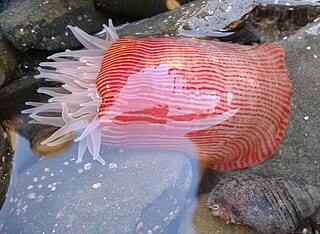
Anthozoa is a class of marine invertebrates which includes the sea anemones, stony corals and soft corals. Adult anthozoans are almost all attached to the seabed, while their larvae can disperse as part of the plankton. The basic unit of the adult is the polyp; this consists of a cylindrical column topped by a disc with a central mouth surrounded by tentacles. Sea anemones are mostly solitary, but the majority of corals are colonial, being formed by the budding of new polyps from an original, founding individual. Colonies are strengthened by calcium carbonate and other materials and take various massive, plate-like, bushy or leafy forms.

Heteractis magnifica, also known by the common names magnificent sea anemone or Ritteri anemone, is a species of sea anemone belonging to the Stichodactylidae family native to the Indo-Pacific area.

Urticina crassicornis, commonly known as the mottled anemone, the painted anemone or the Christmas anemone, is a large and common intertidal and subtidal species of sea anemone. Its habitat includes a large portion of the coastal areas of the northern hemisphere, mainly polar regions, and it lives a solitary life for up to 80 years. Mottled anemones are similar to Dahlia anemones and both are commonly referred to as northern red anemones.

Sea anemones are a group of predatory marine invertebrates constituting the order Actiniaria. Because of their colourful appearance, they are named after the Anemone, a terrestrial flowering plant. Sea anemones are classified in the phylum Cnidaria, class Anthozoa, subclass Hexacorallia. As cnidarians, sea anemones are related to corals, jellyfish, tube-dwelling anemones, and Hydra. Unlike jellyfish, sea anemones do not have a medusa stage in their life cycle.

Condylactis gigantea is a tropical species of ball anemone that is found in shallow reefs and other shallow inshore areas in the Caribbean Sea – more specifically the West Indies – and the western Atlantic Ocean including southern Florida through the Florida Keys. It is also commonly known as: giant Caribbean sea anemone, giant golden anemone, condylactis anemone, Haitian anemone, pink-tipped anemone, purple-tipped anemone, and Florida condy. This species can easily be seen growing in lagoons or in inner reefs as either individuals or loose groups, but never as colonies. They are often used as a model organism along with others in their genus for facultative symbiosis with monocellular algae.

Diadumene lineata, the orange-striped green sea anemone, has several morphotypes which have been described multiple times.

Epiactis prolifera, the brooding, proliferating or small green anemone, is a species of marine invertebrate in the family Actiniidae. It is found in the north-eastern Pacific. It has a feature rare among animals in that all individuals start life as females but develop testes later in their lives to become hermaphrodites.

Epiactis is a genus of sea anemones in the family Actiniidae. There are about nineteen recognised species and the type species is Epiactis prolifera.

Sagartia troglodytes is a species of sea anemone in the family Sagartiidae, also known as the mud sagartia or the cave-dwelling anemone.

Metridium senile, the Plumose, Fluffy, or Frilled anemone, is a species of sea anemone in the family Metridiidae. As a member of the genus Metridium, it is a type of plumose anemone and is found in the seas off north-western Europe and both the east and west coasts of North America.

Sagartia elegans, the elegant anemone, is a species of sea anemone in the family Sagartiidae. It is found in coastal areas of northwest Europe at depths down to 50 metres.

Calliactis polypus is a species of sea anemone in the family Hormathiidae. It is usually found living on the surface of a sea snail shell in which a hermit crab is living.

Urticina eques is a species of sea anemone in the family Actiniidae. It is commonly known as the white-spotted rose anemone or strawberry anemone.

Metridium farcimen is a species of sea anemone in the family Metridiidae. It is commonly known as the giant plumose anemone or white-plumed anemone. It is found in the eastern Pacific Ocean from Alaska down to Catalina Island, California.

Cerianthus lloydii is a species of tube-dwelling sea anemone in the family Cerianthidae. It is sometimes called the lesser cylinder anemone and is found in shallow seas around the coasts of north west Europe.

Bartholomea annulata is a species of sea anemone in the family Aiptasiidae, commonly known as the ringed anemone or corkscrew anemone. It is one of the most common anemones found on reefs in the Caribbean Sea.

Epiactis thompsoni, the red-striped anemone, is a species of marine invertebrate in the family Actiniidae, found in New Zealand and South Australia. They are commonly found in the rocky intertidal zone.

Paranthus rapiformis, the onion anemone, is a species of sea anemone in the family Actinostolidae. It was first described by the French naturalist Charles Alexandre Lesueur in 1817 and is native to the northwestern Atlantic Ocean and the Gulf of Mexico.
Epiactis lisbethae, commonly known as Lisbeth's brooding anemone, is a species of sea anemone in the family Actiniidae. It is similar in appearance to the common brooding anemone, and like it is native to shallow waters on the western coast of North America.
Epiactis fernaldi, commonly known as the Fernald brooding anemone, is a species of sea anemone in the family Actiniidae. It is native to shallow waters around the San Juan Islands off the western coast of North America.

















